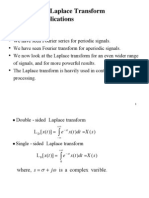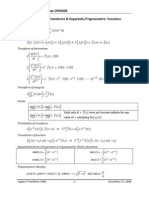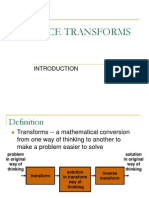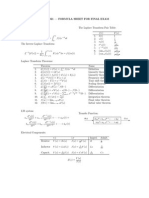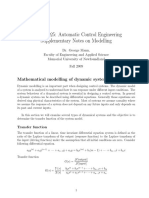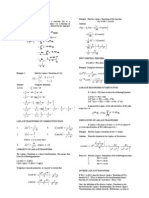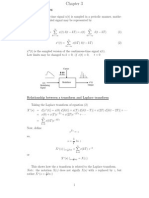Colorado School of Mines CHEN403: FT Yt Fs Ys Gs
Uploaded by
Bongibethu Msekeli HlabanoColorado School of Mines CHEN403: FT Yt Fs Ys Gs
Uploaded by
Bongibethu Msekeli HlabanoColorado School of Mines CHEN403
Linear Open Loop Systems
Linear Open Loop Systems................................................................................................................................ 1
Transfer Function for a Simple Process ....................................................................................................... 1
Example Transfer Function Mercury Thermometer ......................................................................... 2
Desirability of Deviation Variables............................................................................................................ 3
Transfer Function for Process with Multiple Inputs and/or Multiple Outputs ............................ 3
Example Transfer Function Stirred Tank Heater ............................................................................... 5
Transfer Function of Process in Series ......................................................................................................... 8
Poles & Zeros of a Transfer Function ............................................................................................................ 9
Example Poles & Zeros of a Transfer Function............................................................................ 12
Transfer Function for a Simple Process
f (t )
Dynamic
Process
Input
y (t )
f (s)
Output
G(s)
y(s)
Consider the simple process with one input & one output. The describing n-th order ODE
is:
an
dn y
d n1 y
d2 y
dy
+
a
+
+
a
+ a1
+ a0 y = bf ( t )
n 1
2
n
n 1
2
dt
dt
dt
dt
Let us assume we are using deviation variables, so y ( 0) = 0 , and we are starting at
steady state, so:
d n1 y
d2 y
dy
=
=
=
= 0.
n 1
2
dt t =0
dt t =0 dt t =0
Taking the Laplace transform of this gives:
an s n y ( s ) + an1 s n1 y ( s ) + + a2 s 2 y ( s ) + a1 sy ( s ) + a0 y ( s ) = bf ( s )
y(s)
f (s)
an s + an1 s
n
Transfer Functions
n 1
b
G(s)
+ + a2 s 2 + a1 s + a0
-1-
December 21, 2008
Colorado School of Mines CHEN403
where G ( s ) is defined as the transfer function and the simple diagram is called the block
diagram for the process.
Example Transfer Function Mercury Thermometer
Make the following assumptions about the reading from a mercury thermometer:
All resistance to heat transfer is in a thin film around the bulb i.e., neglect thermal
resistance of glass & mercury.
All thermal capacity is in the mercury.
Mercury always has uniform temperature.
The glass wall does not expand or contract.
The energy balance on thermometer will be:
dE d ( E + K + P ) dU dH
=
= hA (Ta T )
dt
dt
dt dt
dT
mC p
= hA (Ta T ) for constant C p
dt
mC p dT
= Ta T
hA dt
dT
T = Ta
dt
where the time constant is:
mC p
hA
At steady state:
T * = Ta*
so in terms of deviation variables:
dT
T = Ta where T ( 0) = 0
dt
Taking the Laplace transform of this ODE gives:
Transfer Functions
-2-
December 21, 2008
Colorado School of Mines CHEN403
( s + 1)T = Ta
so the transfer function is:
G(s) =
T
1
=
Ta s + 1
So, we would expect the heat transfer resistance around a thermometer to be a 1st order
system.
Desirability of Deviation Variables
If we didnt use deviation variables the Laplace transform of the ODE would be:
dT
+ T = Ta ( sT T ( 0 ) ) + T = Ta
dt
( s + 1)T = Ta + T (0)
1
Ta +
T ( 0)
s + 1
s + 1
1
=
Ta +
Ta*
s + 1
s + 1
T=
Now there are two inputs & two transfer functions: one for the driving function ( Ta ( t ) or
Ta ( s ) ) and one for the initial condition ( Ta* ).
Transfer Function for Process with Multiple Inputs and/or Multiple Outputs
What if there are multiple inputs and/or multiple outputs? We would associate a transfer
function with each pairing of an input & output. The block diagram for 2 inputs & 1 output
is:
f1 ( s )
G(s)
f1 ( s )
G1 ( s )
f2 ( s )
G2 ( s )
y(s)
f2 ( s )
+
+
y(s)
The overall relationship for y ( s ) would be:
Transfer Functions
-3-
December 21, 2008
Colorado School of Mines CHEN403
y ( s ) = G1 ( s ) f1 ( s ) + G2 ( s ) f2 ( s )
For n inputs and one output, then:
y ( s ) = G1 ( s ) f1 ( s ) + G2 ( s ) f2 ( s ) + G3 ( s ) f3 ( s ) + + Gn ( s ) fn ( s )
n
y ( s ) = Gi ( s ) fi ( s )
i =1
The block diagram for 2 inputs & 2 outputs is:
f1 ( s )
G1,1 ( s )
+
+
y1 ( s )
G2,1 ( s )
f2 ( s )
G2,1 ( s )
G2,2 ( s )
+
+
y2 ( s )
The overall relationship for the y ( s ) functions would be:
y1 ( s ) = G1,1 ( s ) f1 ( s ) + G1,2 ( s ) f2 ( s )
y2 ( s ) = G2,1 ( s ) f1 ( s ) + G2,2 ( s ) f2 ( s )
For n inputs and m outputs, then:
yi ( s ) = Gi ,1 ( s ) f1 ( s ) + Gi ,2 ( s ) f2 ( s ) + Gi ,3 ( s ) f3 ( s ) + + Gi ,n ( s ) fn ( s )
n
yi ( s ) = Gi , j ( s ) f j ( s ) for i = 1,2,3, , m .
j =1
or in matrix notation as:
y ( s) = G(s ) f ( s )
Transfer Functions
-4-
December 21, 2008
Colorado School of Mines CHEN403
where y ( s ) is a column vector of length m , f ( s ) is a column vector of length n , and G ( s )
is a m n rectangular matrix. G ( s ) is called the transfer function matrix.
Example Transfer Function Stirred Tank Heater
F0, T0, 0
h, A, T,
Fs, Ts
F1, T1, 1
The material balance on this system will be:
d ( h )
dm
= F00 F11 A
= F00 F1
dt
dt
assuming constant cross-sectional area, A . The energy balance is:
dE
= F00 H 0 F11 H 1 + Q = F00 H 0 F1H + Q
dt
Remember, within the tank:
dE d (U + K + P ) dU dH
=
dt
dt
dt dt
So:
dH d VH
=
= F00 H 0 F1H + Q
dt
dt
If we assume that the enthalpy can be expressed as:
Transfer Functions
-5-
December 21, 2008
Colorado School of Mines CHEN403
H = C p (T Tref ) + H ref
then with H ref = 0 & Tref = 0 :
d
VC pT = F00C pT0 F1C pT + Q
dt
d
C p ( VT ) = F00C pT0 F1C pT + Q
dt
d
Q
( VT ) = F00T0 F1T +
dt
Cp
If we assume constant , then:
A
dh
= F0 F1
dt
and:
A
d
Q
( hT ) = F0T0 F1T +
dt
Cp
F
F
d
Q
( hT ) = 0 T0 1 T +
dt
A
A
AC p
TA
dh
dT
Q
+ hA
= F0T0 F1T +
dt
dt
C p
Inserting the material balance:
T ( F0 F1 ) + hA
hA
dT
Q
= F0T0 F1T +
dt
C p
dT
Q
= F0 (T0 T ) +
where h = h( t ) .
dt
C p
If we make the assumption that dh / dt = 0 then V = hA = constant & F0 = F1 , so:
V
dT
Q
= F0 (T0 T ) +
dt
C p
If we are using steam for the heating medium, then we could relate the rate of heat added,
Q , to the steam temperature, Ts , as:
Transfer Functions
-6-
December 21, 2008
Colorado School of Mines CHEN403
Q = UA (Ts T ) .
So:
UA (Ts T )
dT
= F0 (T0 T ) +
dt
C p
dT
UA
UA
+ F0 + T = F0T0 +
Ts
dt
C p
C p
F
dT F0
UA
UA
Ts
+ +
T = 0 T0 +
dt V VC p
V
VC p
dT 1
1
+ + K T = T0 + KTs
F
dt F
dT
1
+ aT = T0 + KTs
dt
F
where:
1 F0
UA
1
,K
, and a + K .
F V
F
VC p
At steady state:
aT * =
1 *
T0 + KTs*
F
so:
dT
1
+ aT = T0 + KTs
dt
F
where the deviation variables are defined as:
T T T * , T0 T0 T0* , and Ts Ts Ts* .
Note that this equation shows how the stirred tank fluid temperature is affected by changes
in the other temperatures.
Transfer Functions
-7-
December 21, 2008
Colorado School of Mines CHEN403
In this Chapter we will convert this equation into one involving transfer functions. Taking
the Laplace transform of the equation gives:
sT T ( 0) + aT =
1
T0 + KTs
F
1
T0 + KTs
F
1
( s + a )T = T0 + KTs
F
1 F
K
T =
T0 +
Ts
s +a
s +a
sT + aT =
This shows that we have two transfer functions:
T = G0 ( s )T0 + Gs ( s )Ts
where:
G0 ( s )
1/ F
K
and Gs ( s )
s +a
s +a
A block diagram for the stirred tank heater can be drawn as follows.
1/ F
s+a
T0 ( s )
+
+
T ( s )
K
s+a
Ts ( s )
Transfer Function of Process in Series
y1(s)
f(s)
G1(s)
y2(s)
G2(s)
Gn(s)
yn(s)
If there are a series of transfer functions, then:
Transfer Functions
-8-
December 21, 2008
Colorado School of Mines CHEN403
yn ( s ) = Gn ( s ) yn1 ( s )
= Gn ( s ) Gn1 ( s ) yn2 ( s )
= Gn ( s ) Gn1 ( s ) G1 ( s ) f ( s )
yn ( s )
f (s)
= Gi ( s )
i =1
Poles & Zeros of a Transfer Function
According to definition of the transfer function:
y(s)
f (s)
= G(s)
where:
G(s) =
Q(s)
P (s)
and where Q ( s ) and P ( s ) are usually polynomials in s (time delays will introduce
exponential terms, however). In general, the order of Q ( s ) will be less than that of P ( s ) .
The roots of the numerator Q ( s ) are referred to as the zeros of the transfer function. At
the zeros, G ( s ) becomes zero. The roots of the denominator P ( s ) are referred to as the
poles of the transfer function. At the poles, G ( s ) becomes infinite.
We can get a qualitative sense of the response of a system by knowing the poles. Let:
f (s) =
r (s)
q(s)
Since:
G(s) =
Q(s)
P( s )
then:
Transfer Functions
-9-
December 21, 2008
Colorado School of Mines CHEN403
y(s) = G(s) f (s) =
Q(s) r (s)
P (s) q(s)
Lets let the roots of P ( s ) be denoted as pi . Then, if P ( s ) is a polynomial of order n and
there are N non-repeating roots and M repeating roots (each one repeating mi times),
then:
N
i =1
i =1
P ( s ) = ( s pi ) ( s pi )
mi
and:
y(s) =
Q(s)
N
r (s)
(s p ) (s p )
i
i =1
q(s)
mi
i =1
When split into partial fractions, each of the factors in the denominator will lead to a
separate term. Splitting up the factors of the transfer function (while leaving the
denominator from the input function aside for now) gives:
mi 1
N
C
y(s) = i +
i =1 s pi
i =1
D (s p )
j ,i
j =0
( s pi )
mi
M mi 1
D j ,i
Ci
y(s) =
+
mi j
i =1 s pi
i =1 j =0 ( s pi )
r* (s)
q( s)
r* (s)
+
.
q(s)
Note that for the repeated root, the numerator can be a polynomial of order up to one less
the order of denominator. Also, each repeated root can have a different order. The only
requirement on the number of roots is that they have to add up to n , i.e.:
M
n = N + mi .
i =1
When we invert the Laplace transforms, then:
N C N
L1 i = C i exp ( pi t ) .
i =1 s pi i =1
Transfer Functions
- 10 -
December 21, 2008
Colorado School of Mines CHEN403
M mi 1
D j ,i
L1
mi j
i =1 j =0 ( s pi )
M mi 1
D j ,i
= L1
mi j
i =1 j =0
s
p
(
)
i
M
mi 1
D
= exp ( pi t ) L1 mij,i j
i =1
s
j =0
mi 1
= exp ( pi t )
j =0 ( mi
i =1
M
mi 1
= exp ( pi t )
j =0 ( m
i =1
i
( m j 1)!
L1 i mi j
j 1 )!
s
D j ,i
t mi j 1
j 1 )!
D j ,i
Note that the roots pi are important for the long-time characteristics of the solution. For
the real non-repeating roots:
If pi < 0 , then exp ( pi t ) 0 as t . This exponential decay leads to a zero
contribution from this pole.
If pi > 0 , then exp ( pi t ) as t . This exponential growth leads to a explosive
contribution from this pole.
If pi = 0 , then exp ( pi t ) = 1 for all t . This constant term should not lead to any
instability.
For the complex non-repeating roots (which will occur as a complex conjugate pair), then
pi can be expressed as i i i . These roots will give rise to terms of the form
exp ( i t ) sin ( i t + i ) . Now, the important term with regards to stability is the real portion
of the root, i :
If i < 0 , then exp ( i t ) sin ( i t + i ) 0 as t . This exponential decay leads to a
zero contribution from this pole.
If i > 0 , then exp ( i t ) sin ( i t + i ) as t . This exponential growth leads to
a explosive contribution from this pole.
If i = 0 , then exp ( i t ) sin ( i t + i ) = sin ( i t + i ) for all t . This term will lead to a
stable oscillation.
For the repeating roots, the situation is similar. The polynomial term will always grow
towards infinity as t , so the behavior of the exponential term will dictate the overall
behavior.
If pi < 0 or i < 0 , then the exponential term will go to zero as t and the entire
term will also go to zero. This exponential decay leads to a zero contribution from
this pole.
Transfer Functions
- 11 -
December 21, 2008
Colorado School of Mines CHEN403
If pi > 0 or i > 0 , then the exponential term will grow to infinity as t and the
entire term will also grow to infinity. This exponential growth leads to an explosive
contribution from this pole.
If pi = 0 or i = 0 , then the polynomial term will dictate the behavior for t .
This polynomial term will lead to an explosive contribution from this pole..
So, in general:
If i < 0 , stable contribution from this pole.
If i > 0 , unstable contribution from this pole.
If i = 0 , stable contribution only if non-repeated root unstable contribution if
repeated root.
Example Poles & Zeros of a Transfer Function
Given the transfer function:
G(s) =
Q(s)
P (s)
Q(s)
s + 3s + 5s 2 + 4s + 2
4
find the zeros & determine if stable.
The following chart shows the characteristics of P ( s ) vs. s . Note that there are no real
roots.
Transfer Functions
- 12 -
December 21, 2008
Colorado School of Mines CHEN403
10
9
8
7
6
P (s ) 5
4
3
2
1
0
-2.5
-2
-1.5
-1
-0.5
0.5
1.5
2.5
Can factor P ( s ) to get:
P ( s ) = s 4 + 3s3 + 5s 2 + 4s + 2 = ( s 2 + s + 1 )( s2 + 2s + 2)
From this, we find that the roots are:
r=
1 1 4 1 1
1
3
i
=
2
2 2
r=
2 22 4 1 2
= 1 i
2
Since the real portion of the roots are all negative, the system is stable.
Transfer Functions
- 13 -
December 21, 2008
You might also like
- System Dynamics and Respinse Kelly Solutions100% (6)System Dynamics and Respinse Kelly Solutions447 pages
- Ch4.Laplace Transform and Circuit AnalysisNo ratings yetCh4.Laplace Transform and Circuit Analysis61 pages
- Process Dynamics and Control, Ch. 11 Solution Manual100% (9)Process Dynamics and Control, Ch. 11 Solution Manual29 pages
- Mathematical Madeling and Block DiagramaaNo ratings yetMathematical Madeling and Block Diagramaa93 pages
- Chapter 5: Laplace Transform and Its ApplicationsNo ratings yetChapter 5: Laplace Transform and Its Applications23 pages
- A. Karamancıo Glu Electrical Engineering DepartmentNo ratings yetA. Karamancıo Glu Electrical Engineering Department16 pages
- Feedback and Control System(Updated 0214)No ratings yetFeedback and Control System(Updated 0214)33 pages
- Step Functions and Laplace Transforms of Piecewise Continuous FunctionsNo ratings yetStep Functions and Laplace Transforms of Piecewise Continuous Functions20 pages
- Computational Modelling of Steady Diffusion Process: Prof. Nilanjan Chakraborty E-MailNo ratings yetComputational Modelling of Steady Diffusion Process: Prof. Nilanjan Chakraborty E-Mail34 pages
- Worksheet On Laplace Transforms: 1 Definitions and PropertiesNo ratings yetWorksheet On Laplace Transforms: 1 Definitions and Properties3 pages
- Using The Fourier Transform To Solve PdesNo ratings yetUsing The Fourier Transform To Solve Pdes4 pages
- General Forced Response: P T N B P T N A A T FNo ratings yetGeneral Forced Response: P T N B P T N A A T F11 pages
- Class Test - 2016: Electrical EngineeringNo ratings yetClass Test - 2016: Electrical Engineering11 pages
- Modeling: ∞ −st 1 s 1 s n n! s −at 1 s+a ω s +ω s s +ωNo ratings yetModeling: ∞ −st 1 s 1 s n n! s −at 1 s+a ω s +ω s s +ω4 pages
- 10.1 Laplace Transfer Functions For BuildingThermal ControlNo ratings yet10.1 Laplace Transfer Functions For BuildingThermal Control7 pages
- SM212 Practice Test 3, Prof Joyner: Sin (T) (The Convolution of TNo ratings yetSM212 Practice Test 3, Prof Joyner: Sin (T) (The Convolution of T5 pages
- Applications of Laplace Transform Unit Step Functions and Dirac Delta FunctionsNo ratings yetApplications of Laplace Transform Unit Step Functions and Dirac Delta Functions8 pages
- ENGR 6925: Automatic Control Engineering Supplementary Notes On ModellingNo ratings yetENGR 6925: Automatic Control Engineering Supplementary Notes On Modelling31 pages
- Student Solutions Manual to Accompany Economic Dynamics in Discrete Time, secondeditionFrom EverandStudent Solutions Manual to Accompany Economic Dynamics in Discrete Time, secondedition4.5/5 (2)
- 10.450 Process Dynamics, Operations, and Control Lecture Notes - 21 Lesson 21. Controllers 21.0 ContextNo ratings yet10.450 Process Dynamics, Operations, and Control Lecture Notes - 21 Lesson 21. Controllers 21.0 Context5 pages
- AT Attachment With Packet Interface - 7 Volume 1No ratings yetAT Attachment With Packet Interface - 7 Volume 1390 pages
- Joining The Ties of Kinship - Islamic NetworkNo ratings yetJoining The Ties of Kinship - Islamic Network4 pages
- Java Spring Boot Microservices Example - Step by Step Guide - GeNo ratings yetJava Spring Boot Microservices Example - Step by Step Guide - Ge13 pages
- 5b Chemical Energetics - IGCSE Chemistry (0620)No ratings yet5b Chemical Energetics - IGCSE Chemistry (0620)21 pages
- 3-Dimensional Drawings, or Photographic or Pictorial Drawings. Isometric DrawingNo ratings yet3-Dimensional Drawings, or Photographic or Pictorial Drawings. Isometric Drawing32 pages
- GR 9 Final Assessment Datesheet and SyllabusNo ratings yetGR 9 Final Assessment Datesheet and Syllabus7 pages
- 48.lamp Illumination Control System Using Sensor CircuitNo ratings yet48.lamp Illumination Control System Using Sensor Circuit4 pages
- St. Bernard Parish Gov't v. United States, No. 05-1119L (Fed. Cl. May 1, 2015)100% (1)St. Bernard Parish Gov't v. United States, No. 05-1119L (Fed. Cl. May 1, 2015)74 pages
- On The Method of Ship's Transoceanic Route PlanningNo ratings yetOn The Method of Ship's Transoceanic Route Planning8 pages
- Transmission Removal & Installation - Metro & Firefly (Canadian)No ratings yetTransmission Removal & Installation - Metro & Firefly (Canadian)2 pages
- African Daisy Orange: Dimorpotheca Greek Dis (Twice) + Morphe (Shape) + Theka (A Fruit)No ratings yetAfrican Daisy Orange: Dimorpotheca Greek Dis (Twice) + Morphe (Shape) + Theka (A Fruit)11 pages
- ALMCO Risk Assessment Kitchen & Dinning Area-JAN 2021No ratings yetALMCO Risk Assessment Kitchen & Dinning Area-JAN 202110 pages
- Process Dynamics and Control, Ch. 11 Solution ManualProcess Dynamics and Control, Ch. 11 Solution Manual
- A. Karamancıo Glu Electrical Engineering DepartmentA. Karamancıo Glu Electrical Engineering Department
- Step Functions and Laplace Transforms of Piecewise Continuous FunctionsStep Functions and Laplace Transforms of Piecewise Continuous Functions
- Computational Modelling of Steady Diffusion Process: Prof. Nilanjan Chakraborty E-MailComputational Modelling of Steady Diffusion Process: Prof. Nilanjan Chakraborty E-Mail
- Worksheet On Laplace Transforms: 1 Definitions and PropertiesWorksheet On Laplace Transforms: 1 Definitions and Properties
- Modeling: ∞ −st 1 s 1 s n n! s −at 1 s+a ω s +ω s s +ωModeling: ∞ −st 1 s 1 s n n! s −at 1 s+a ω s +ω s s +ω
- 10.1 Laplace Transfer Functions For BuildingThermal Control10.1 Laplace Transfer Functions For BuildingThermal Control
- SM212 Practice Test 3, Prof Joyner: Sin (T) (The Convolution of TSM212 Practice Test 3, Prof Joyner: Sin (T) (The Convolution of T
- Applications of Laplace Transform Unit Step Functions and Dirac Delta FunctionsApplications of Laplace Transform Unit Step Functions and Dirac Delta Functions
- ENGR 6925: Automatic Control Engineering Supplementary Notes On ModellingENGR 6925: Automatic Control Engineering Supplementary Notes On Modelling
- Student Solutions Manual to Accompany Economic Dynamics in Discrete Time, secondeditionFrom EverandStudent Solutions Manual to Accompany Economic Dynamics in Discrete Time, secondedition
- Transformation of Axes (Geometry) Mathematics Question BankFrom EverandTransformation of Axes (Geometry) Mathematics Question Bank
- Computer Solved: Nonlinear Differential EquationsFrom EverandComputer Solved: Nonlinear Differential Equations
- Shortcuts to College Calculus Refreshment KitFrom EverandShortcuts to College Calculus Refreshment Kit
- A Complete Course in Physics (Graphs) - First EditionFrom EverandA Complete Course in Physics (Graphs) - First Edition
- 10.450 Process Dynamics, Operations, and Control Lecture Notes - 21 Lesson 21. Controllers 21.0 Context10.450 Process Dynamics, Operations, and Control Lecture Notes - 21 Lesson 21. Controllers 21.0 Context
- Java Spring Boot Microservices Example - Step by Step Guide - GeJava Spring Boot Microservices Example - Step by Step Guide - Ge
- 3-Dimensional Drawings, or Photographic or Pictorial Drawings. Isometric Drawing3-Dimensional Drawings, or Photographic or Pictorial Drawings. Isometric Drawing
- 48.lamp Illumination Control System Using Sensor Circuit48.lamp Illumination Control System Using Sensor Circuit
- St. Bernard Parish Gov't v. United States, No. 05-1119L (Fed. Cl. May 1, 2015)St. Bernard Parish Gov't v. United States, No. 05-1119L (Fed. Cl. May 1, 2015)
- On The Method of Ship's Transoceanic Route PlanningOn The Method of Ship's Transoceanic Route Planning
- Transmission Removal & Installation - Metro & Firefly (Canadian)Transmission Removal & Installation - Metro & Firefly (Canadian)
- African Daisy Orange: Dimorpotheca Greek Dis (Twice) + Morphe (Shape) + Theka (A Fruit)African Daisy Orange: Dimorpotheca Greek Dis (Twice) + Morphe (Shape) + Theka (A Fruit)
- ALMCO Risk Assessment Kitchen & Dinning Area-JAN 2021ALMCO Risk Assessment Kitchen & Dinning Area-JAN 2021






